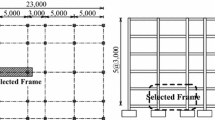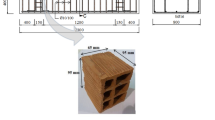Abstract
The ratio of frame strength and stiffness to masonry infill are major parameters that influence the seismic capacity of masonry infill. The influence of such parameters to seismic capacity in terms of strength, stiffness and deformation has significant variations between different design codes and past literature on the topic. This study focused on the in-plane behaviour of unreinforced masonry infill walls installed in reinforced concrete (RC) frames with different strengths. In the first part of this study, two ½ scale specimens with different RC frames and identical masonry infill walls were tested using a static cyclic loading protocol. The main objective was investigating the influence of changing frame strength to seismic capacity in terms of: strength, stiffness and deformation. Results of the presented experiment showed that as the ratio of frame shear strength to masonry shear strength increased, there was great improvement of the masonry infill walls in terms of strength and avoidance of sudden brittle behaviour of the masonry infill. However, varying frame strength did not significantly influence the initial stiffness and story drift at maximum strength. In the second part of this study, an investigation was conducted on the deformation limits of masonry infilled RC frames and the influence of various parameters, based on data collected from many recent experimental tests. Based on these experimental results, the deformation limits of masonry infill were found to be directly proportional to both the compressive prism strength of the masonry infill and the ratio of shear strength of frame to that of the masonry infill. The influence of aspect ratio showed large variation and it is difficult to conclude its level of influence on deformation. A simplified procedure based on experimental data was proposed that can estimate the backbone curve and gave good estimation of the post-peak lateral strength degradation slope based on the ratio of frame strength with simple hand calculation. Such a method is useful in the preliminary design process to help practicing engineers understand the general behaviour expected by infilled RC frames.
















Similar content being viewed by others
Abbreviations
- Β :
-
Ratio of the boundary frame lateral strength to masonry infill shear strength
- V f :
-
Boundary frame lateral strength
- V inf :
-
Masonry infill lateral strength
- f c :
-
Compressive strength of concrete
- f m :
-
Prism compressive strength of masonry infill
- t inf :
-
Infill panel thickness
- l inf :
-
Infill panel length
- M u :
-
Flexural yield moment of the column or beam
- V max :
-
Maximum lateral load of the overall structure (masonry infill and frame)
- h o :
-
Clear height of column
- W ef :
-
Equivalent strut width
- E w , E c :
-
Young’s modulus of the infill wall and the concrete
- H inf , H :
-
Height of infill wall and the story height
- θ :
-
Arctan (Hinf/Linf) (the inclination of the diagonal strut)
- I c , I b :
-
Moment of inertia of the column and of the beam
- f m90 :
-
Prism compressive strength of masonry in horizontal direction
- μ :
-
Coefficient of sliding friction
- d m :
-
Diagonal length of infill panel
- h, l :
-
Height and length of frame
- R crack :
-
Story drift angle at the cracking point
- R max :
-
Story drift angle at maximum strength
- R u :
-
Story drift angle at the strength degradation point is set to be 80% of the maximum strength
- K f :
-
Initial stiffness of frame
- K m :
-
Initial stiffness of masonry infill
- K o :
-
Initial stiffness of whole system (masonry infill and RC frame)
- ε peak :
-
Masonry prims compression strain at maximum compression stress
- δ max :
-
Lateral displacement at maximum lateral load
- V res :
-
The residual strength of RC frame and masonry infill
- R res :
-
The story drift at point of V res
References
Al-Nimry HS (2014) Quasi-static testing of RC infilled frames and confined stone-concrete bearing walls. J Earthq Eng 18:1–23
Al-Washali H, Suzuki Y, Maeda M (2017) Seismic evaluation of reinforced concrete buildings with masonry infill wall. In: The 16th world conference of earthquake engineering, Chile
American Society of Civil Engineers (ASCE) (2007) Seismic rehabilitation of existing buildings. Reston, Virginia (ASCE/SEI 41-06)
American Society of Testing and Materials (ASTM) (2011) Standard test method for compressive strength of masonry prisms. ASTM C1314, West Conshohocken, PA
Architectural Institute of Japan (AIJ) (2016) AIJ standard for lateral load-carrying capacity calculation of reinforced concrete structures (in Japanese)
Basha SH, Kaushi HB (2016) Behavior and failure mechanisms of masonry-infilled RC frames (in low-rise buildings) subject to lateral loading. J Eng Struct 111:233–245
Blackard B, Willam K, Mettupalayam S (2009) Experimental observations of masonry infilled RC frames with openings. ACI Special Publication, SP-265-9
Bose S, Rai DC (2016) Lateral load behavior of an open-ground-story RC building with AAC infills in upper stories. Earthq Spectra 32(3):1653–1674. doi:10.1193/121413EQS295M
Chopra Anil K (2007) Dynamics of structures, theory and application to earthquake engineering, 3rd edn. Pearson Prentice Hall, Upper-Saddle River
FEMA 306 (1998) Evaluation of earthquake damaged concrete and masonry wall buildings, Applied Technology Council (ATC-43 Project)
Flanagan RD, Bennett RM (1999) In-plane behavior of structural clay tile infilled frames. J Struct Eng 125(6):590–599
Imran L, Aryanto A (2009) Behavior of reinforced concrete frames in-filled with lightweight materials under seismic loads. Civil Eng Dimens 11(2):69–77
Japanese Industrial Standards (2010) Japanese Standards Association, No. JIS R1250, JIS Z 2201, JIS A 1108, JIS A 1113 (in Japanese)
Jin KW, Choi H, Nakano Y (2016) Experimental study on lateral strength evaluation of unreinforced masonry-infilled RC frame. Earthq Spectra 32:1725–1747. doi:10.1193/00714EQS152M
Kakaletsis DJ, Karayannis CG (2009) Experimental investigation of infilled reinforced concrete frames with openings. ACI Struct J 106(2):132–141
Kaushik HB, Rai DC, Jain SK (2007) Stress-strain characteristics of clay brick masonry under uniaxial compression. J Mater Civil Eng (ASCE) 19(9):728–739
Liauw TC, Kwan KH (1985) Unified Plastic analysis for infilled frames. J Struct Eng 111(7):1427–1448
Maidiawati, Sanada Y (2017) R/C frame–infill interaction model and its application to Indonesian buildings. Earthq Eng Struct Dyn 46(2):221–241
Mainstone RJ (1971) Summary of paper 7360: on the stiffness and strength of infilled frames. Proc Inst Civil Eng 49:230. doi:10.1680/iicep.1971.6267
Mehrabi AB, Shing PB, Schuller M, Noland J (1996) Experimental evaluation of masonry-infilled RC frames. J Struct Eng ASCE 122(3):228–237
New Zealand Society for Earthquake Engineering (NZSEE) (2006) Assessment and Improvement of the Structural Performance of Buildings in Earthquakes. NZSEE, Wellington, New Zealand, Section 9
Paulay, T. and Priestley, M.J.N. (1992) Seismic design of reinforced concrete and masonry buildings. Wiley, New York
Saneinejad A, Hobbs B (1995) Inelastic design of infilled frames. J Struct Eng 121(4):634–650
Suzuki T, Choi H, Sanada Y, Nakano Y, Matsukawa K, Paul D, Gülkan P, Binici B (2017) Experimental evaluation of the in-plane behavior of masonry wall infilled RC frames. Bull Earthq Eng. doi:10.1007/s10518-017-0139-1
Turgay T, Durmus MC, Binici B, Ozcebe G (2014) Evaluation of the predictive models for stiffness, strength, and deformation capacity of RC frames with masonry infill walls. J Struct Eng 140:06014003. doi:10.1061/(ASCE)ST.1943-541X.0001069
Wood RH (1978) Plasticity, composite action and collapse design of unreinforced shear wall panels in frames. Proc Inst Civil Eng Part 2 65:381–411
Acknowledgements
The study presented in this article was sponsored by the Science and Technology Research Partnership for Sustainable Development (SATREPS) project funded by JST (Japan Science and Technology Agency) and JICA (Japan International Cooperation Agency) for Bangladesh, 2015 project headed by Professor Nakano Yoshiaki, University of Tokyo and it’s gratefully acknowledged. Opinions expressed in this article are those of the authors, and do not necessarily represent those of the SATREPS project.
Author information
Authors and Affiliations
Corresponding author
Rights and permissions
About this article
Cite this article
Alwashali, H., Torihata, Y., Jin, K. et al. Experimental observations on the in-plane behaviour of masonry wall infilled RC frames; focusing on deformation limits and backbone curve. Bull Earthquake Eng 16, 1373–1397 (2018). https://doi.org/10.1007/s10518-017-0248-x
Received:
Accepted:
Published:
Issue Date:
DOI: https://doi.org/10.1007/s10518-017-0248-x




